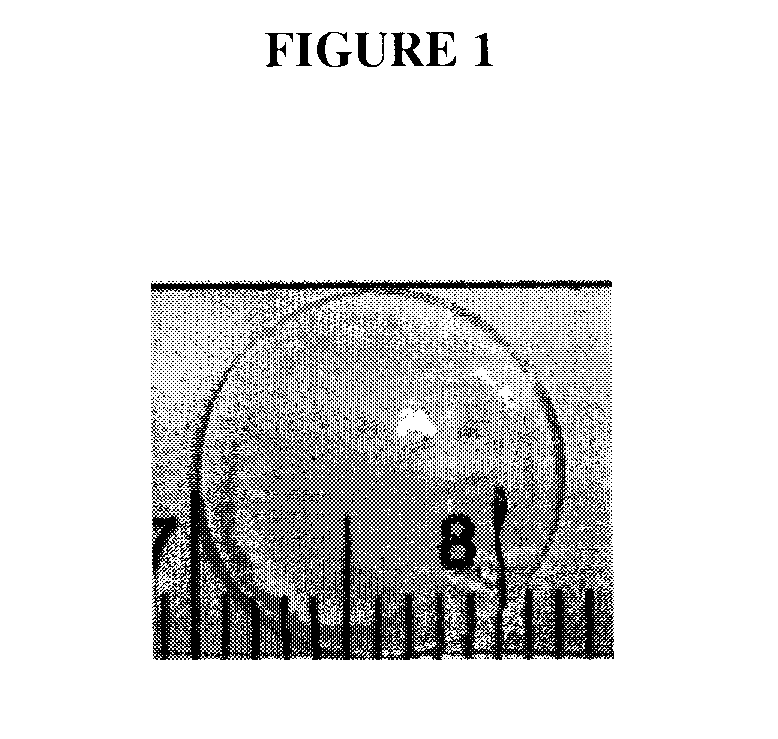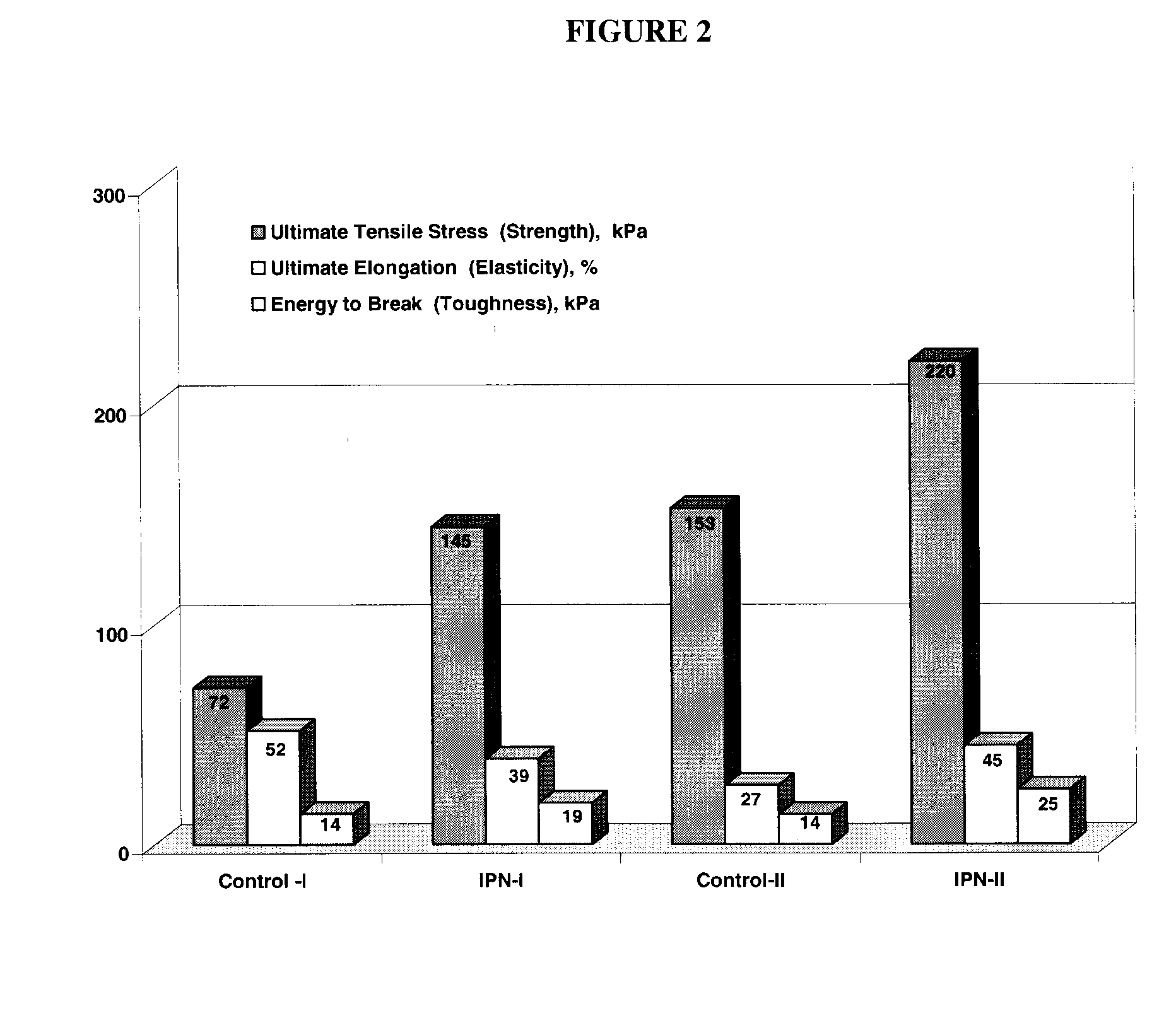Interpenetrating Networks, and Related Methods and Compositions
a polymer network and interpenetrating technology, applied in the direction of macromolecular non-active ingredients, powder delivery, prosthesis, etc., can solve the problems of material elasticity and optimum toughness for easy handling during surgery
- Summary
- Abstract
- Description
- Claims
- Application Information
AI Technical Summary
Benefits of technology
Problems solved by technology
Method used
Image
Examples
example i
NiColl / MPC IPNs Hydrogels
[0081]Materials. Nippon collagen (swine skin); 0.625 M morpholinoethanesulfonic acid [MES, containing Aalizarin Red S pH indicator (6.5 mg / 100 ml water)]; 1-ethyl-3-(3-dimethyl aminopropyl) carbodiimide HCl (EDC), N-hydroxy-succinimide(NHS). MPC (2-methacryloyloxyethyl phosphorylcholine) was purchased from Biocompatibles International PLC (UK). NaOH solution (2N); PEG-diacrylate (Mw=575 Da); and ammonium persulfate (APS) and N,N,N′,N′-tetramethyl ethylene diamine (TEMED) were purchased from Sigma-Aldrich.
[0082]Preparation of NiColl / MPC IPNs Hydrogels. Initially, 0.3 ml of 13.7 wt % Nippon collagen solution and 0.1 ml of 0.625 M MES were mixed in two syringes connected with a plastic Tee in an ice-water bath. Subsequently, 12.9 mg of MPC (ratio of collagen to MPC was 4:1 w / w) was dissolved in 0.25 ml of MES, of which 0.2 ml was injected into the above mixture via a 100 μl microsyringe. Next, 4.6 μl of PEG-diacrylate, in weight ratio to MPC of 1:2, was injecte...
example ii
NiColl / MPC IPNs Hydrogels
[0099]This study was performed to demonstrate the ability to alter the characteristics of IPNs prepared as in Example I by increasing the concentration of collagen solution from 13.7% to 20% at an EDC / Coll-NH2 ratio of 1.5. Additionally, MES lacking a pH indicator was used.
[0100]Materials. Nippon collagen (swine skin); 0.625 M morpholinoethanesulfonic acid [MES, without pH indicator]; 1-ethyl-3-(3-dimethyl aminopropyl) carbodiimide HCl (EDC); N-hydroxy-succinimide(NHS). MPC was purchased from Biocompatibles Internationl PLC (UK). NaOH solution (2N); PEG-diacrylate (Mw=575 Da); ammonium persulfate(APS); and N,N,N′,N′-tetramethyl ethylene diamine (TEMED) were provided by Aldrich.
Preparation of NiColl / MPC IPNs Hydrogels.
[0101]Initially, 0.3 ml of 20.0 wt % Nippon collagen solution and 0.1 ml of MES (0.625 M) were mixed in two syringes connected with a plastic Tee in ice-water bath. Next, 12.9 mg of MPC (ratio of collagen to MPC, 4 / 1 w / w) was dissolved in 0.25 m...
example iii
Novel Biosynthetic Materials for Vision Enhancing Ophthalmic Devices
[0112]The tissue-engineered materials described in this example are essentially robust implantable materials with enhanced toughness and elasticity in comparison to materials previously known. Although they are collagen-based, they also incorporate biomimetic molecules such as chitosan that emulate natural extracellular matrix molecules (ECM) found within the human cornea while conferring significantly increased tensile strength. In addition, a hybrid cross-linking system was developed and used for stabilization of collagen / chitosan scaffolds to further enhance elasticity and toughness of the material. These enhanced materials were tested for mechanical, optical, and biological properties. Results suggest that scaffolds are tough, elastic, and superior to human eye bank corneas in optical clarity, and allow regeneration of corneal cells and nerves in vitro.
Materials and Methods
[0113]The base material comprised a mix...
PUM
| Property | Measurement | Unit |
|---|---|---|
| diameter | aaaaa | aaaaa |
| temperature | aaaaa | aaaaa |
| humidity | aaaaa | aaaaa |
Abstract
Description
Claims
Application Information
 Login to View More
Login to View More - R&D
- Intellectual Property
- Life Sciences
- Materials
- Tech Scout
- Unparalleled Data Quality
- Higher Quality Content
- 60% Fewer Hallucinations
Browse by: Latest US Patents, China's latest patents, Technical Efficacy Thesaurus, Application Domain, Technology Topic, Popular Technical Reports.
© 2025 PatSnap. All rights reserved.Legal|Privacy policy|Modern Slavery Act Transparency Statement|Sitemap|About US| Contact US: help@patsnap.com



